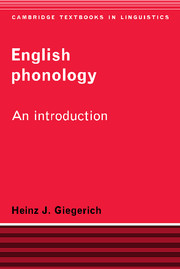Book contents
- Frontmatter
- Contents
- Preface
- 1 Speech sounds and their production
- 2 Towards a sound system for English: consonant phonemes
- 3 Some vowel systems of English
- 4 Phonological features, part 1: the classification of English vowel phonemes
- 5 Phonological features, part 2: the consonant system
- 6 Syllables
- 7 Word stress
- 8 Phonetic representations: the realisations of phonemes
- 9 Phrases, sentences and the phonology of connected speech
- 10 Representations and derivations
- References
- Index
8 - Phonetic representations: the realisations of phonemes
Published online by Cambridge University Press: 05 June 2012
- Frontmatter
- Contents
- Preface
- 1 Speech sounds and their production
- 2 Towards a sound system for English: consonant phonemes
- 3 Some vowel systems of English
- 4 Phonological features, part 1: the classification of English vowel phonemes
- 5 Phonological features, part 2: the consonant system
- 6 Syllables
- 7 Word stress
- 8 Phonetic representations: the realisations of phonemes
- 9 Phrases, sentences and the phonology of connected speech
- 10 Representations and derivations
- References
- Index
Summary
The phonetic level of representation
It will have become clear by now that the phonological analysis pursued in this book recognises two significant levels of representation. On the one hand, there is the abstract phonemic level, on which only phonologically relevant properties are represented, where phonological relevance is defined as phonological contrastiveness: the representations of two segments differ on this level if this difference serves to distinguish words. Segments that are distinct on this level of representation are called phonemes, and minimal pairs (pit – bit) constitute proof of the phonemic status of segments (here of /p/ and /b/). Phonemic inventories are not only language-specific; they even differ, as we saw in chapters 2 and 3, from accent to accent. To complete the picture of the phonemic level, we saw in chapter 7 that certain suprasegmental properties may also be phonemic: English word stress is phonemic under a strictly phonemicist methodology – recall minimal pairs such as ‘abstract – ab'stract.
The phonetic level of representation, on the other hand, contains not only the phonologically relevant information that is also present on the phonemic level; it contains also all the information that is redundant – phonetic features, that is, which are not utilised in the phonemic distinctions of the language. On this level, the representation of an utterance is fleshed out with phonetic details. The question is, how fully fleshed out are such phonetic representations in our theory?
- Type
- Chapter
- Information
- English PhonologyAn Introduction, pp. 208 - 248Publisher: Cambridge University PressPrint publication year: 1992



